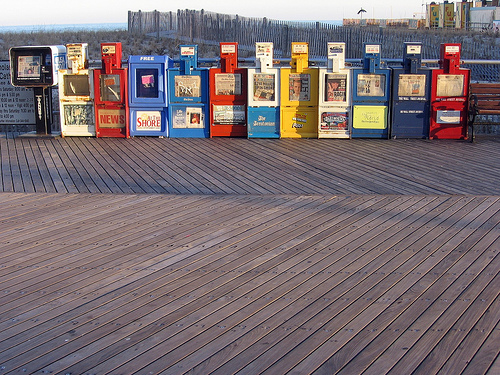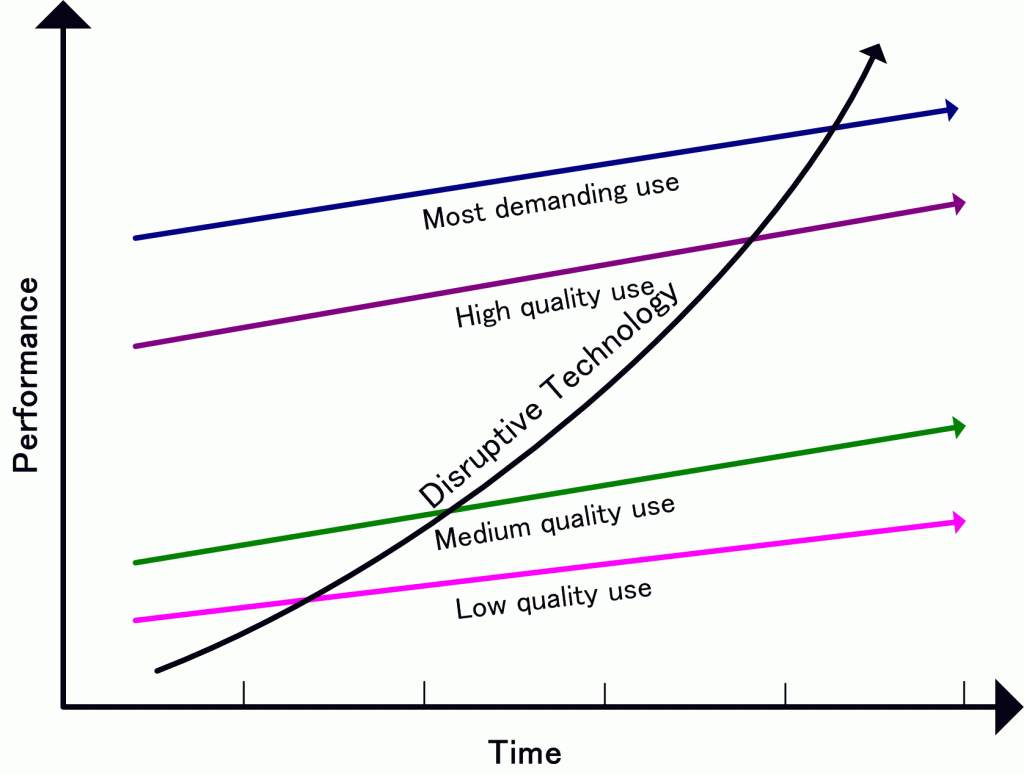If I ran the world, no one would be allowed to opine about the decline of the newspaper industry until they’d read The Innovator’s Dilemma. The web is so clearly a disruptive technology, and the newspaper industry is so clearly following the trajectory Christensen describes in his book, that it’s hard to think clearly about the process if you haven’t grasped Christensen’s key insights. To review, the key attribute of a disruptive technology is that when it’s introduced into the marketplace, it is cheaper but also markedly inferior to the incumbent technology, as judged by the criteria of the dominant technology’s customers. Internet-based news clearly fits this pattern. As newspaper people never tire of reminding us, Internet-based news outlets rarely have the resources to staff expensive foreign bureaus, conduct in-depth fact-checking, fly sports reporters to away games, hire teams of lawyers, and so on. If the Huffington Post or TechCrunch were judged as newspapers, they would be pretty lousy ones.
What we learn from The Innovator’s Dilemma is this state of affairs is completely normal when a disruptive technology invades an established industry. If you talked to a DEC executive in 1978 about the Apple II, he would have pointed out, correctly, that it was vastly inferior to the computers DEC sold. It had less memory, fewer peripherals, a slower processor, less disk space, was less reliable, had inferior tech support, and so on. Yet it turns out this didn’t matter, for two reasons. First, there were many, many people for whom the microcomputer was “good enough.” And second, as Apple, IBM, and others began to sell microcomputers at high volume, they steadily closed the performance gap. By the 1980s, minicomputers were still vastly more expensive than microcomputers, but their technical advantages had become much smaller.
So newspaper partisans are absolutely right to point out that newspapers continue to be superior to online news sources in a number of respects. But they’re completely wrong to think this can save them. Because as Mike Masnick explained recently (and as illustrated by the above chart), Christensen’s work tells us that newspapers’ performance advantages won’t last—online news companies will figure out ways to negate the newspapers’ traditional advantages in reliability, comprehensiveness, and so forth. At the same time, newspapers are probably not going to figure out how to get their costs down to the level where they’re competitive with web-only publications.
Now, I think this second point is something that the newspaper industry’s critics often fail to grasp. Newspaper CEOs are often portrayed as ignorant luddites that are clinging to paper despite the obvious advantages of the Web. They’re frequently told that if they would just “change their business moel,” everything would be OK. I hope it’s clear from Tuesday’s post why this is wrong. A newspaper is a large, bureaucratic institution whose every department is carefully crafted to maximize its profitability as a publisher of newspapers. It owns printing presses, warehouses, delivery trucks, newspaper boxes, and other assets that are totally useless for publishing a website. It has a large staff of paper boys, sales representatives, typesetters, customer service representatives and so forth who would have to be retrained or (more likely) laid off. And most importantly, it has an institutional culture that’s fundamentally about publishing newspapers. The St. Louis Post-Dispatch can’t just stop printing newspapers any more than DEC could have just stopped making minicomputers. Doing so would have meant discarding the vast majority of what made the company valuable.
 I actually think that some of the leading newspapers are doing astonishingly well given the economic constraints they face. The New York Times in particular has done a magnificent job of building a world-class, innovative website. It not only does a great job of presenting the Times print content, but it’s also chock full of interactive features, blogs, and even innovative software releases. Similarly, the Washington Post was an early pioneer in the web-based journalism business. In fact, they followed the exact strategy Christensen recommends for incumbents facing disruptive innovation: to build a subsidiary that’s physically and logically separate from the main company. That’s why Washingtonpost.Newsweek Interactive is headquartered in Arlington, VA, across the Potomac from the Washington Post Company’s DC headquarters. And I think the effort has borne fruit; the Washington Post has one of the best and most popular news websites in the world.
I actually think that some of the leading newspapers are doing astonishingly well given the economic constraints they face. The New York Times in particular has done a magnificent job of building a world-class, innovative website. It not only does a great job of presenting the Times print content, but it’s also chock full of interactive features, blogs, and even innovative software releases. Similarly, the Washington Post was an early pioneer in the web-based journalism business. In fact, they followed the exact strategy Christensen recommends for incumbents facing disruptive innovation: to build a subsidiary that’s physically and logically separate from the main company. That’s why Washingtonpost.Newsweek Interactive is headquartered in Arlington, VA, across the Potomac from the Washington Post Company’s DC headquarters. And I think the effort has borne fruit; the Washington Post has one of the best and most popular news websites in the world.
Which isn’t to say their websites will necessarily be profitable enough to allow their parent companies to escape bankruptcy (The Post may avoid bankruptcy simply because it owns a profitable test-prep subsidiary). But I’m skeptical that they, or any newspaper, could have done very much better. Very few firms have ever survived disruptive innovations in their core markets, and the ones that do survive almost always emerge bruised and battered. It would be par for the course if most newspapers went bankrupt. It will be far more surprising if a significant number of them avoid bankruptcy.
Now, I should acknowledge that Christensen himself has written about this subject and he doesn’t entirely agree with me. He penned an article in 2006 arguing that “although it’s too early to point to billion-dollar businesses, we have seen mind-sets shift and managers get excited as they see the massive growth potential that still exists for the industry.” What follows is frankly underwhelming. Christensen gestures in the general direction of some sensible but not terribly original business models, and promises more details in a report Christensen did for the American Press Institute. If you’ll forgive my cynicism, I wonder if he sugar-coated his conclusions a bit for the benefit of his sponsor.
Indeed, I think a similar tension is evident in The Innovator’s Dilemma itself. In the introduction, Christensen writes “colleagues who have read my academic papers reporting the findings recounted in chapters 1 through 4 were struck by their near-fatalism.” But he then goes on to reassure readers that “there are, in fact, sensible ways to deal effectively with this challenge.” I wonder if he turned in fatalistic first draft, only to have his publisher sit him down and explain that business books are sold to corporate executives, and corporate executives aren’t likely to buy a book that tells them they’re business is doomed no matter what they do.
In any event, Christensen never really delivers on his promise of solutions to the innovator’s dilemma. The strategies he suggest are fine as well as they go, but he finds only a handful of companies that have (narrowly) escaped bankruptcy, compared with many companies that simply went broke. Whether the API likes it or not, that’s the fate that likely awaits most of the nation’s newspapers—not because newspapers are badly run, but simply because they’re based on an outmoded technology for distributing the news.




Great piece Tim. Radley Balko pointed out your blog a couple weeks ago and I’ve been enjoying the material.
Pretty much everyone arguing against your basic position has seemed like a whiny xenophobe, with the exception of one guy: David Simon. Not that his argument has been substantially different (newspapers hold value that online pubs don’t, and news companies need to start charging for online content). A couple recent columns he’s written:
http://www.cjr.org/feature/build_the_wall_1.php?page=all
http://www.washingtonpost.com/wp-dyn/content/article/2009/02/27/AR2009022703591.html
He makes some good points though, especially about keeping the government and police accountable (of course, now that CNN is stealing criminal justice stuff from Radley, maybe he has that backwards). And, given the work that he’s done in the past, I can’t help but give his opinion some weight. Is this just a case of the art having more intellectual integrity than the artist (something I’ve considered with Simon before)? Or is he making points that need to be considered in this debate?
Anyway, keep up the good work!
Thanks, I’ll check those out!